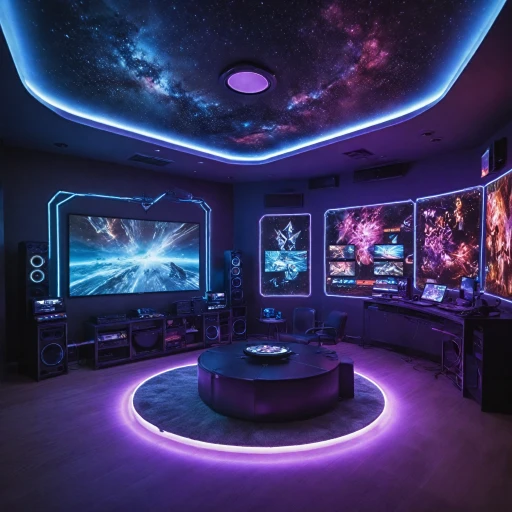The Evolution of PlayStation Consoles
The New Era of PlayStation Consoles
The journey of PlayStation consoles began with the landmark introduction of Sony to the gaming world. Over the years, PlayStation has not only transformed but has consistently set benchmarks in the gaming industry. Each generation from Sony has pushed boundaries — from the original PlayStation to the latest PlayStation 5.
By examining past milestones, such as the innovative introduction of the DualSense controller and the stellar console sales performance, one can appreciate the evolution that has occurred. The release of the PlayStation 4 brought profound updates in gaming hardware and software capabilities, capturing a significant portion of the market alongside competitors like Xbox Series and Nintendo Switch.
The thrilling jump to PlayStation 5 further expanded this legacy, showcasing a powerful console that supports visually stunning games like "Call of Duty" and numerous exclusives. With increasing consumer expectations and technological advancements, each Sony generation becomes more sophisticated, reshaping the parameters of gaming experiences.
The cycle of a new generation console is not only gauged by technical specs but also by market demand and price points. Sony's strategy, much like the effective pricing of PlayStation 4 Pro and their timely release dates, has been integral to maintaining hardware spending enthusiasm. As anticipation mounts around what a future console like the PS6 might bring, the latest updates and speculations will provide a context for understanding the trajectory of these beloved consoles.
Speculations and Rumors Surrounding the PS6
The Buzz Around PlayStation 6
In the world of gaming consoles, anticipation and excitement build as gamers look forward to what innovations the next generation of PlayStation might bring. The PlayStation 6 (PS6) is no exception, with plenty of speculation and rumors making the rounds in the community. The PlayStation 6 is expected to continue the legacy of its predecessors, which have historically set a high bar for gaming technology. As one looks at the evolution of PlayStation consoles, it is evident that every new release carries with it substantial hardware advancements. This naturally leads to speculation about the potential features and the pro version options that the PS6 might bring to the table. Several gaming enthusiasts are discussing the possible inclusion of more advanced hardware that can support the next generation of video games with ease. Some rumors suggest enhancements in the dualsense controller and increased compatibility with virtual and augmented reality technologies. The PlayStation 5 already supports these features, yet the PS6 might enhance them significantly. Another point of speculation is the possible release date for the PS6. Typically, PlayStation consoles have followed a pattern of release every six to seven years. Considering the launch of the PlayStation 5 in late 2020, forecasts point to a PS6 release around the mid to late 2020s. Of course, precise dates and specs remain closely guarded by Sony. Many are also curious about how favorably the PS6 will be priced compared to its competitive counterparts like the Xbox Series and the Nintendo Switch. Price remains a crucial factor influencing console sales, often impacting the choice of console for many gamers. Sony's State of Play events might give hints towards the PS6 in the days ahead, keeping gamers and industry experts alike on their toes. While official news is still awaited, Sony will undoubtedly aim to exceed consumer expectations and deliver one of the best gaming experiences in this generation. For now, gamers continue to enjoy the current offerings, while keeping a watchful eye on any updates or leaks that might give new insights into what could be the PlayStation best release yet.Technological Trends Influencing the Next Console
Technological Inspirations for the Next Generation
As we anticipate what the future holds for the next PlayStation console, several technological advancements are shaping how Sony may approach its development. Although the specifics of the PlayStation 6 hardware remain under wraps, emerging trends provide insight into what might drive its innovation. One significant aspect is the continuous evolution of gaming hardware, where every generation strives to outdo the last. The PlayStation 5 made headlines with its cutting-edge graphics and super-fast SSD which revolutionized loading times, setting a new benchmark. As we've seen, the quest for realism in video game graphics demands ever-powerful GPUs, meaning the PlayStation 6 will likely feature even more advanced visual capabilities. Moreover, the integration of AI and machine learning in gaming has been making waves recently. Enhanced AI can lead to more responsive and intelligent NPCs, providing gamers with richer, more immersive experiences. Sony might tap into this trend to further bridge the gap between reality and video game worlds in their next console. The harmony between software and hardware will continue to be of paramount importance. Users expect seamless interaction between games and the console itself, as exemplified by the DualSense controller's innovative haptic feedback. Efficient hardware and sophisticated software integration should be a focal point for Sony's future vision. Finally, the shift towards cloud gaming cannot be ignored. With platforms like the Xbox Cloud Gaming offering a glimpse into gaming’s future, Sony could further explore cloud-based solutions, potentially impacting how and where games are played. In essence, these technological strides pave the way for a revolution in the gaming industry. For deeper insights into such innovations and their implications on future consoles, you might find this exploration of the technological landscape of past gaming systems fascinating.Market Demand and Consumer Expectations
Understanding Consumer Needs and Market Trends
As we look ahead to the potential release of a new generation of PlayStation consoles, understanding market demand and consumer expectations is crucial for forecasting the PlayStation 6's success. In recent years, the gaming industry has witnessed significant growth with a notable increase in hardware spending. This trend is driven by consumers eager to experience the latest advancements in gaming technology, such as the highly acclaimed DualSense controller introduced with the PlayStation 5.
Consumers have grown accustomed to highly immersive experiences, expecting improved graphics, faster processing speeds, and more engaging gameplay. Sony, with its PlayStation brand, alongside competitors like Xbox and Nintendo Switch, must continuously innovate to capture and maintain the interest of both casual and dedicated gamers. The integration of virtual reality features, cross-platform play capabilities, and backward compatibility has become a significant priority for gamers, who seek flexibility and enhanced interactivity.
The competitive landscape in the gaming console market is notably influenced by factors like console sales performance and the ongoing rivalry with other key players. The Xbox Series, for example, poses a formidable competition, offering alternatives that demand Sony's proactive strategies to differentiate itself. The PlayStation's reputation for delivering exclusive titles, such as the popular Call of Duty series, continues to bolster its appeal, though consumers remain vigilant about price and value for their investment.
With every new generation, market dynamics evolve, and companies must decipher and respond to consumers' desires and expectations. Information gleaned from state of play events and the latest industry news points to an increasing consumer appetite for diversity and innovation. Addressing these preferences will be instrumental for Sony to solidify its foothold in the ever-expanding and competitive gaming landscape, ensuring that the PlayStation brand remains at the forefront of the industry for years to come.
Challenges in Gaming Console Development
Unveiling the Mysteries of Gaming Console Development
Developing a new gaming console is not a simple endeavor, especially for an industry giant like Sony. The PlayStation's journey through generations has shown significant advancements, yet it also highlights the complexities involved. With each new release, such as the highly anticipated PlayStation 6, there are numerous challenges that manufacturers face.
1. Balancing Performance with Price: Each generation of PlayStation has pushed the envelope in terms of performance, graphics, and gameplay experience. However, meeting consumer expectations while keeping the console's price point competitive is a perennial challenge. Sony must carefully consider hardware advancements and the resulting costs to ensure the console remains accessible to a broad audience.
2. Competing in a Dynamic Market: The gaming console landscape has intensified with rivals like Xbox Series and Nintendo Switch, each presenting unique innovations. Sony needs to understand market trends and consumer preferences, especially as they gear up for the PS6 launch, to stand out amidst stiff competition and capture gamers' attention.
3. Managing Hardware Advancements: As technology rapidly evolves, the pressure to incorporate the latest hardware advancements into new consoles mounts. The PlayStation 6 will likely embrace cutting-edge technology to enhance gameplay. However, advancing too quickly can lead to production delays and increase the risk of defects, challenging Sony's ability to stick to an expected release date.
4. Adapting to Players’ Expectations: Today's gamers expect seamless gameplay experiences. This includes swift loading times, exceptional graphics, and engaging games like 'Call of Duty' designed specifically for next-gen consoles. Meeting these expectations while innovating with new features like the DualSense controller is crucial for console sales.
In summary, while developing the next-generation PlayStation, Sony faces several strategic decisions and technical hurdles. Successfully navigating these challenges will determine the PlayStation 6's impact on console sales and overall market position.











